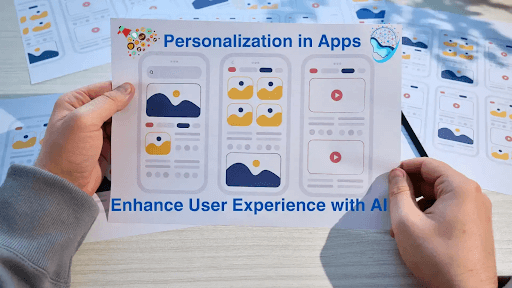In this digital age, mobile apps play a big role in the success of any business. They affect how we talk and learn. But many people can’t use them. As per a survey, over 1 billion people have disabilities that limit access. We need apps that are easy to use for all.
AI helps create apps for everyone. Studies show that accessible technology can reach four times the intended audience, making inclusivity also a wise business strategy. AI improves app access in many ways. Voice control helps people with sight issues. Predictive text aids learning disabilities.
AI personalized learning paths too. These tools enhance the user experience. They build an inclusive digital world where all people benefit. Integrating AI in app development is crucial for accessibility. We’ll show how AI advances usability and access for millions.
Understanding AI for Accessibility
AI for Accessibility utilizes smart tech to simplify app usage for all, including the disabled. Disabilities mean difficulties with sight, hearing, or learning in typical ways. AI gives computers a “brain” to assist with such hurdles.
Picture an app that speaks out what’s on screen for those with vision challenges or auto-subtitles during videos for the hearing-impaired. AI makes apps usable despite one’s limitations.
This isn’t about adding a feature or two. It’s about identifying all possible support needs and using AI accordingly. Some may struggle with complex instructions; AI simplifies things. Others find physical controls hard; AI allows voice or gesture control.
AI for Accessibility helps makes mobile apps easier for everyone to use. It is a set of tools to address varied challenges. As tech advances, more helpful tools get added.
When app development companies in the USA build apps with AI for Accessibility, they ensure apps work for all people. It opens mobile apps to everyone, leaving no one out. That’s the core purpose.
AI’s Role in Boosting Accessibility Features
AI unlocks possibilities for mobile apps to be more user-friendly for all, especially the disabled. Imagine an app adapting to needs like reading text aloud for the visually impaired or captioning videos for the hearing impaired. AI offers smart solutions making apps not just accessible but enjoyable for everyone.
With AI, apps can now understand the world like humans. For those with vision issues, it describes images, and converts text to speech. So all get the full picture, no matter their eyesight. For the hearing impaired, AI live-captions videos ensure they don’t miss any dialogue or action.
AI helps make apps easier to use. It lets people control apps with voice or gestures. This helps those who struggle with touch screens. Before AI, this level of interaction was hard. But now, AI makes it real in mobile app design.
For people who find learning or remembering difficult, AI offers predictive text and tailored suggestions. These features suggest words or content, making the digital world more approachable and less frustrating. AI learns and grows with the user, creating a personalized experience suited to their needs.
AI transforms how apps are designed, bringing us closer to technology that works for everyone. It’s not just about adding features but creating a seamless, intuitive experience that adapts to individual needs. AI makes the digital landscape accessible, ensuring no one is left behind. This smart approach to app development changes how we interact with technology. It opens doors for everyone to explore, learn, and connect in ways once unimaginable.
Improving Visual Accessibility Through AI
AI breaks down barriers for the visually impaired, offering a richer mobile experience. Let’s see how AI makes this happen.
- Object recognition tech helps you see digital items. It tells you what’s there. You point your phone at things. Then it describes them clearly. This is powerful. It makes digital visuals open to those with sight issues.
- Image description tells you about photos and icons in apps. It’s like having a friend explaining your screen. You won’t miss any action. It works for posts, games, etc. AI ensures everyone understands visuals fully.
- Text-to-speech reads out content for you. Articles, menus, anything in text form. This helps those who struggle reading screens. It’s like an audiobook for all text, with one tap.
- AI’s visual accessibility keeps adapting too. It gets smarter with each use. So it tailors help to your needs. Whether a quick visual description or complex layout guidance, AI smoothens experiences.
Making apps open to all is key. AI helps achieve that. Mobile app development companies in Chicago don’t just build apps, but design experiences welcoming visually impaired users. This step forward opens the digital world equally, providing access to info, fun, and social links. Through AI, visual accessibility in mobile apps grows daily, opening exciting possibilities.
AI-Powered Solutions for Hearing Impairments
For those with hearing issues, AI in apps makes life easier. AI helps in many ways: Real-time captions convert speech to on-screen text instantly. It’s like having a personal assistant writing every spoken word, ensuring nothing’s missed. The speech-to-text technology transcribes speech into messages so voice inputs are readable, aiding smooth communication.
- Audio descriptions verbally describe visuals. For action-packed videos, AI narrates what’s happening. Even without sound effects or music, users understand the full story. It’s like having a narrator painting the scene, keeping all included in the action.
- AI gets better at knowing accents. So captions and text will be clearer, no matter who speaks. Not just for fun, these features help learn, work, and keep in touch. With AI, hearing issues won’t block your favorite apps.
- AI makes mobile apps easy to use for disabled people too. Voice commands let you speak to apps, find songs, call friends without tapping. Gesture controls scroll pages, pick things, and play games with just a wave or nod. It feels like the app reads your mind, making things simple.
Making Mobile Apps More Navigable with AI
Mobile apps can feel like mazes, mainly for disabled users. But AI lets everyone move freely in digital spaces.
- Voice commands are handy AI tools. You talk to the app, find music, and call mates without swiping. Helpful if you struggle with hands or eyesight.
- Gesture controls are game-changers too. Just wave or nod to scroll, select, play games. Great for those with movement issues. The app understands gestures, giving you smooth sailing.
- Typing is now easier with predictive text input. Your phone suggests words as you type. This is AI guessing what you might say next. It saves time and reduces errors. For people with typing difficulties, this makes a frustrating task much simpler.
These AI features make apps more user-friendly. They make the experience more inclusive and enjoyable. By understanding natural commands, whether spoken or through gestures, apps become like helpful companions rather than just tools.
AI Enhances Learning for Those with Cognitive Challenges
AI technology is making a huge difference for those who find learning challenging. Think about learning something new and understanding it. AI aims to make that happen more often for everyone, including those with cognitive or learning disabilities.
Apps use artificial intelligence (AI) to suggest content that matches your interests. If you struggle to focus or remember details, this can guide you toward topics you’ll understand and enjoy. AI lets apps simplify menus and layouts for users who find navigation difficult. It’s like having an app customized just for you, preventing frustration.
AI also powers fun, interactive learning tools. These use quizzes, games, or virtual reality to teach concepts. People who learn by doing rather than reading or listening can benefit. AI creates a personal tutor in your app, teaching in ways that make sense to you. Apps are becoming bridges to learn and experience the world.
Conclusion
AI for Accessibility is a win-win, ensuring mobile apps are user-friendly for everyone. AI, or artificial intelligence, makes it possible to design apps that are enjoyable regardless of disabilities. This tech helps people who may see, hear, learn, or move in different ways. What once seemed like a dream is now becoming reality.
Moving ahead, we see mobile app development companies in Dallas create smarter app solutions that make life easier. The future looks promising. As AI advances, we’ll see more amazing ways to enhance app accessibility. Regardless of abilities, the mobile app world will be open to everyone.
Also check – The Future of .NET Development: Trends and Predictions



